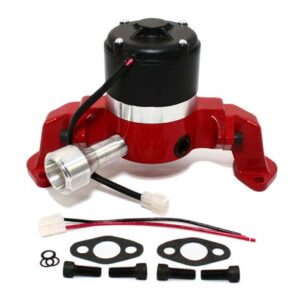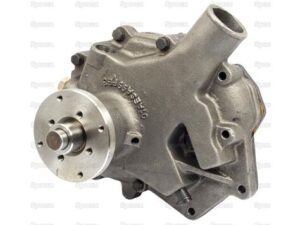semi truck water pump, Learn about semi truck water pump functions, signs of replacement, selection tips, DIY replacement, and maintenance for long-lasting performance.When it comes to the reliable performance of your semi truck, the importance of a high-quality water pump cannot be overstated. A semi truck water pump plays a crucial role in regulating engine temperature, ensuring that your vehicle runs smoothly even under the toughest conditions. Understanding the functions and maintenance of this vital component can save you from potential breakdowns and costly repairs down the line. In this article, we will delve into the workings of a semi truck water pump, signs indicating a need for replacement, tips for selecting the right pump, and essential DIY replacement advice. Additionally, we’ll provide insights on maintaining your water pump for optimal longevity. Equip yourself with the knowledge to keep your semi truck in peak condition and ensure it can handle any journey ahead.
Understanding The Function Of A Semi Truck Water Pump
The semi truck water pump is a critical component of the engine cooling system, ensuring efficient operation and longevity of the vehicle. Its primary function is to circulate coolant throughout the engine and radiator, maintaining an optimal temperature during operation. Without a properly functioning water pump, the engine can overheat, leading to severe damage and costly repairs.
When the engine runs, the water pump draws coolant from the radiator and pushes it through the engine block and cylinder head. This process absorbs heat produced by the engine and transports it back to the radiator, where it is cooled down before recirculating. This continuous flow helps to prevent hotspots that can cause engine damage and ensures that the semi truck operates within the necessary temperature range.
semi truck water pump, In addition to maintaining the engine temperature, the water pump also plays a role in ensuring proper cabin heating. It directs hot coolant into the heater core, which then transfers heat to the cabin, providing comfort to the driver and passengers during colder weather conditions.
Overall, the semi truck water pump is indispensable for maintaining optimal engine performance, preventing overheating, and ensuring driver comfort. Regular checks and maintenance of this component are crucial for the longevity of the vehicle and should not be overlooked.
Common Signs Your Semi Truck Water Pump Needs Replacement
Identifying when your semi truck water pump needs replacement is crucial for maintaining your vehicle’s overall performance. Here are some common signs to watch for:
- Overheating Engine: If your engine temperature gauge shows higher than normal readings, it could indicate an issue with the water pump.
- Leaking Coolant: Puddles of coolant underneath your semi truck can signify a failing water pump seal or crack.
- Noisy Operation: A whirring or grinding noise coming from the front of your engine may suggest that the water pump bearings are worn.
- Reduced Coolant Flow: Check for a decrease in coolant flow in the radiator; this can indicate the water pump isn’t circulating properly.
- Check Engine Light: If your warning light illuminates on the dashboard, it could signal water pump issues among other potential problems.
Timely detection of these signs can help you prevent extensive damage to your semi truck engine and prolong the lifespan of your vehicle.
How To Choose The Right Water Pump For Your Semi Truck
semi truck water pump, When it comes to selecting the right water pump for your semi truck, there are several critical factors to consider to ensure optimal performance and longevity. Here’s a breakdown to help guide your decision:
- Compatibility: Ensure the water pump is compatible with your specific make and model of semi truck. Referring to your truck’s service manual can provide insights into the manufacturer-recommended pump models.
- Material Quality: Look for pumps made from high-quality materials that can withstand the demands of heavy-duty use. Cast iron and aluminum are common, but be sure to choose one that offers durability and resistance to corrosion.
- Flow Rate: Different pumps have varying flow rates, which can affect performance. Make sure to choose a pump that meets the cooling needs of your semi truck engine.
- Brand Reputation: Opt for reputable brands that have a track record of reliability and customer satisfaction. Research reviews and feedback from other semi truck owners to guide your choice.
- Warranty: A good warranty can be indicative of a manufacturer’s confidence in their product. Ensure the water pump you choose comes with a solid warranty to protect your investment.
- Cost: While it’s tempting to choose the cheapest option, consider the long-term benefits of investing in quality. Sometimes, spending a little more initially can save you significantly on repairs or replacements down the line.
By taking these factors into account, you can select a water pump that not only fits your semi truck but also enhances its efficiency and reliability.
DIY Tips For Replacing A Semi Truck Water Pump
Replacing a semi truck water pump can be a manageable task for those with basic mechanical skills. Here are some DIY tips to help you through the process:
By following these steps, you can effectively replace the water pump in your semi truck, ensuring your vehicle continues to operate efficiently.
Maintaining Your Semi Truck Water Pump For Longevity
Keeping your semi truck water pump in peak condition is crucial for ensuring optimal engine performance and preventing costly repairs. Here are some essential maintenance tips to enhance the longevity of your water pump:
By adhering to these maintenance tips, you can significantly extend the life of your semi truck water pump, ensuring reliable and efficient operation. Regular upkeep not only saves you money but also enhances your truck’s overall performance on the road.
Frequently Asked Questions
What is the primary function of a semi truck water pump?
The primary function of a semi truck water pump is to circulate coolant through the engine and the cooling system to maintain an optimal operating temperature.
How do I know if my semi truck water pump is failing?
Signs of a failing water pump may include overheating engine, coolant leaks, unusual noises, or a dashboard warning light.
What are the common causes of water pump failure in semi trucks?
Common causes of water pump failure include excessive wear and tear, corrosion, inadequate coolant levels, and faulty seals.
How often should the water pump be replaced in a semi truck?
It is generally recommended to inspect or replace the water pump every 100,000 to 150,000 miles, although this can vary based on the manufacturer’s guidelines.
Can I drive my semi truck if the water pump is malfunctioning?
semi truck water pump, It is not advisable to drive your semi truck with a malfunctioning water pump as it can lead to engine overheating and severe damage.
What are the steps to replace a semi truck water pump?
To replace a water pump, you typically need to drain the coolant, remove the old pump, install the new pump, and then refill the cooling system with coolant.
Should I hire a professional mechanic for water pump issues or can I do it myself?
While some experienced individuals may tackle water pump replacement themselves, it is often best to hire a professional mechanic to ensure the job is done correctly and safely.




